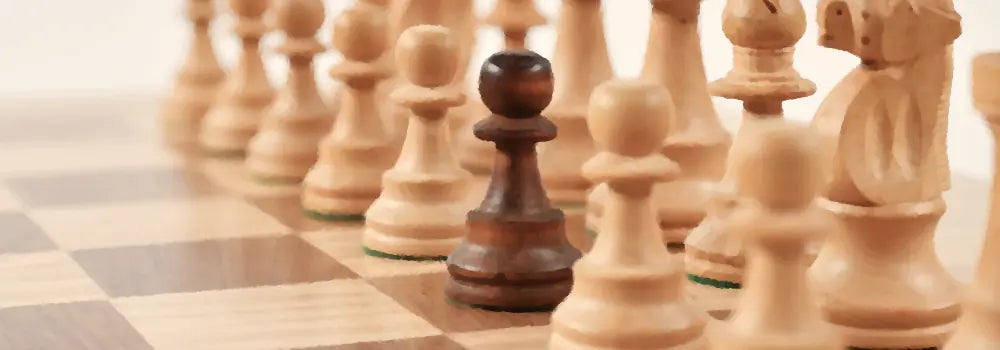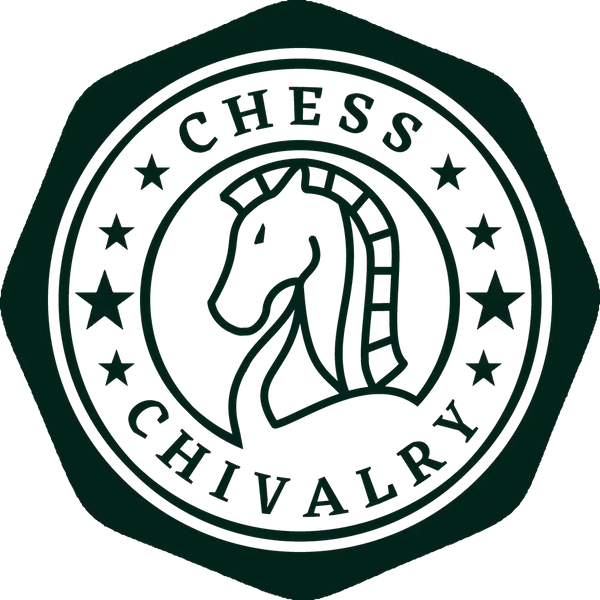
Chess & Strategy: The Pawn Structure
Share
Pawn structures are one of the most fundamental concepts in chess. They determine the strategic plans of both chess players and can significantly influence the outcome of the game. A pawn structure refers to the arrangement of the pawns on the chessboard, which can vary greatly from game to game. The choice of chess opening has a significant influence on the pawn structure. In the opening phase of the game, this determines which pawns are moved to which square in the attack and which squares are defended by them. Since pawns usually also defend each other, they have a direct influence on the freedom of movement of all other chess pieces on the chessboard. An understanding of pawn structures therefore helps to prepare one's own strategy and to hinder the opponent in his strategy.
In this article I would like to analyse the different pawn structures to show tips and advice that can improve your game.
Pawn Chains
A pawn chain is a group of pawns that are connected vertically on the chessboard. Pawn chains are an important discipline in chess strategy as they support each other and form a strong foundation from which all other chess pieces can operate. The most common type of pawn chain is the central pawn chain, which includes the pawns on d4 and e4 (or d5 and e5 for Black). A strong pawn chain in the centre can be a valuable advantage in chess, as it helps to defend the central squares and thus gain control of the board. In addition, an efficiently built pawn structure in the opening phase buys the player time to develop his other chess pieces and thus align his strategy.

It is important to note, however, that not all pawn chains are created equal. Depending on the position of the pawns and the chess pieces surrounding them, some pawn chains may be weaker than others. For example, a pawn chain that has moved too far forward can become vulnerable to attack, while a pawn chain that is not supported by pieces can be easily broken. Moreover, pawn chains can also be used offensively to create weak points in the opponent's position. By attacking an opponent's pawn chain with your own pawns, you can create weaknesses in the opponent's pawn structure and thus reveal new attacking options. Very early moves that pursue such an intention are the so-called gambits, which weaken the pawn structures on both sides and thus reveal more playing options for both players.
Pawn Break-through
In chess, a pawn breakthrough (also called a pawn advance) is a pawn move played with the intention of destroying the opponent's pawn structure. This can create weak spots in the opponent's position, making it easier for the player to gain control of important squares on the board and launch an attack. The pawn break is a powerful tactical concept in chess. It can be used to open lines from which your chess pieces can operate, and they give you the opportunity to launch a successful attack. A well-timed pawn breakthrough can also thwart your opponent's plans and force him to react to your moves.

White is under pressure: on c5 Black can advance with his c-pawn if White does not strengthen the defence. White is threatened with open attack lines on the queenside.
There are several factors to consider when planning a pawn breakthrough. One important consideration is the position of your own chess pieces on the board. You must ensure that your pieces are positioned to take advantage of the new lines opened by the pawn break. A pawn break without a subsequent attack is ineffective and only complicates the position of the pieces.
The other important consideration is the position of the opponent's pawns. The opponent's pawn structure must be carefully evaluated and its weaknesses identified. An attack on a weak pawn that is not adequately defended followed by an offensive advance can cause significant weaknesses in the opponent's position.
The timing of the pawn breakthrough is crucial to its success. If you start it too early, your pawns may not be sufficiently developed and you may lack offensive power. If, on the other hand, you wait too long, the opposing player may beat you to it or already have built up a defence for his pawn structure. Good tactical calculation of moves and good interplay with your opening are crucial for an efficient and quick advance. It is best to look at the tactical options of your opening as you move into the middlegame to assess a pawn breakthrough.
Isolated Pawns
An isolated pawn is a pawn that does not have another pawn to defend on any adjacent side. This type of pawn structure is common in chess and can be caused by capturing a pawn or by a pawn advance, resulting in a hole in the pawn structure.
A pawn isolated in this way can become a significant disadvantage, as it is vulnerable to attack and represents a weakness in the defensive line. It is difficult to defend in most cases, as it is not supported by other pawns on the same row and defence with more valuable pawns is often not worthwhile. Nevertheless, it represents a loss should it be captured.

With the support of the black king, the black pawns will surely gain the upper hand, as White cannot effectively integrate his isolated pawn.
To avoid isolated pawns in your pawn structure, it is important to pay close attention to your pawn moves and plan your pawn structure carefully. Avoid making pawn moves that leave your pawns unsupported or tear holes in your pawn structure. Instead, try to maintain a solid pawn structure that supports your pawns and limits weaknesses in your position.
Careless handling of one's pawns is one of the most widespread weaknesses in chess. In particular, the low value of a single pawn drives many players to underestimate it and sacrifice or capture with it at every opportunity. However, since pawns act in unison with each other, the values of several pawns usually have to be considered in combination to enable comparability with other chess pieces. It is not uncommon for the loss from a broken pawn structure to weigh more heavily than the gain from a previously captured knight.
Doubled Pawns
In chess, a double pawn is a pawn structure where two pawns of the same colour are stacked vertically on the same piece. This can be the result of a capture or a pawn advance that moves a pawn to the adjacent line. Double pawns can be both an advantage and a disadvantage, depending on the position. On the one hand, double pawns can create new lines of operation for one's pieces, allowing more control over important squares on the board. They can also create weak points in the opponent's position, making it easier for you to launch an attack.
On the other hand, double pawns can also be a significant disadvantage. They can limit the mobility of your pieces, making it difficult to coordinate an effective attack. Double pawns can also be vulnerable and difficult to defend, especially if they are isolated or have no support from other pawns.

After an exchange in the centre, White has a double pawn which has severely weakened the queenside.
In general, it is best to avoid creating double pawns if possible. For this, it is important to plan your pawn moves carefully and weigh up whether attacking with the pawn generates a good countervalue to the formation of the double pawn. In most cases, however, this is not the case, unless a bishop or knight can be won due to a mistake by the opponent.
If you do end up with double pawns in your pawn structure, it is important to evaluate the position carefully and determine whether the double pawns are an advantage or a disadvantage. If they can be used to create new lines for your pieces or to create weak points in the opponent's position, they can be a valuable advantage. However, if they are blocked and thus restrict one's mobility or create weak points in one's position, it may be necessary to sacrifice them in order to maintain a strong position on the board. If it is not possible to sacrifice them, a swift repositioning of your pawns and a shift of the attack away from the double pawns must compensate for the weakened position.
Conclusion
In summary, pawn structure is a fundamental aspect of chess strategy and can significantly influence the outcome of a game. The way the pawns are placed on the board determines the strengths and weaknesses of a player's position and extends into the endgame.
The following insights can be derived from this consideration:
- Keep your pawn chains together and make sure the pawns defend each other.
- Evaluate the position and timing of your planned pawn breakthrough carefully.
- Avoid isolated pawns, if this is not possible, try to defend them afterwards
- Avoid double pawns, as they usually block the flow of the game and weaken your position.
Even though this article on pawn structures only covers the basics, I hope you were able to get some help to improve your game.
If you have any further questions, feel free to contact me via my contact form. And if you are interested in chess pieces or chessboards in tournament format, have a look at my assortment.
I wish you a lot of fun with the game, much success and fast learning progress.
See you soon.
Stefan
